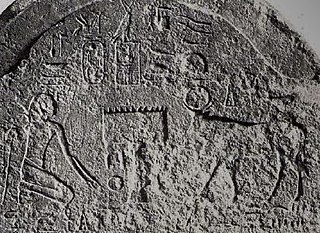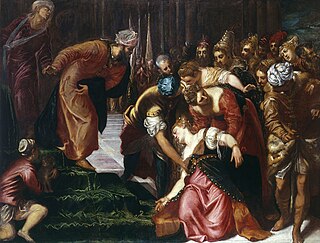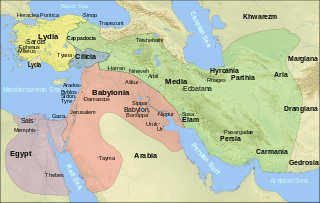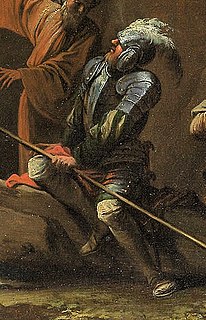Related Research Articles

Amasis II or Ahmose II was a pharaoh of the Twenty-sixth Dynasty of Egypt, the successor of Apries at Sais. He was the last great ruler of Egypt before the Persian conquest.
The 6th century BC started the first day of 600 BC and ended the last day of 501 BC.

Cambyses II was the second King of Kings of the Achaemenid Empire from 530 to 522 BC. He was the son and successor of Cyrus the Great and his mother was Cassandane.

Darius I, commonly known as Darius the Great, was the third Persian King of Kings of the Achaemenid Empire, reigning from 522 BCE until his death in 486 BCE. He ruled the empire at its peak, when it included much of West Asia, parts of the Caucasus, parts of the Balkans, most of the Black Sea coastal regions, Central Asia, as far as the Indus Valley in the far east and portions of north and northeast Africa including Egypt (Mudrâya), eastern Libya, and coastal Sudan.
This article concerns the period 529 BC – 520 BC.

Ahasuerus is a name applied in the Hebrew Bible to three rulers and to a Babylonian official in the Book of Tobit.
The year 521 BC was a year of the pre-Julian Roman calendar. In the Roman Empire, it was known as year 233 Ab urbe condita. The denomination 521 BC for this year has been used since the early medieval period, when the Anno Domini calendar era became the prevalent method in Europe for naming years.

Bardiya, also named as Tanyoxarces by Ctesias, was a son of Cyrus the Great and the younger brother of Cambyses II, both Persian kings. There are sharply divided views on his life. Bardiya either ruled the Achaemenid Empire for a few months in 522 BC, or was impersonated by a magus called Gaumāta, until he was toppled by Darius the Great.

Atossa was an Achaemenid empress. She was a daughter of Cyrus the Great, and a sister-wife of the Persian king of kings Cambyses II and wife of Darius I.

Cyrus II of Persia, commonly known as Cyrus the Great, and also called Cyrus the Elder by the Greeks, was the founder of the Achaemenid Empire, the first Persian empire.

Persis, better known in English as Persia, or Persia proper, is the Fars region, located to the southwest of the modern Iran, now a province. The Persians are thought to have initially migrated either from Central Asia or, more probably, from the north through the Caucasus. They would then have migrated to the current region of Persis in the early 1st millennium BC. The country name Persia was derived directly from the Old Persian Parsa.

The Late Period of ancient Egypt refers to the last flowering of native Egyptian rulers after the Third Intermediate Period in the 26th Saite Dynasty founded by Psamtik I, but includes the time of Achaemenid Persian rule over Egypt after the conquest by Cambyses II in 525 BC as well. The Late Period existed from 664 BC until 332 BC, following a period of foreign rule by the Nubian 25th Dynasty and beginning with a short period of Neo-Assyrian suzerainty, with Psamtik I initially ruling as their vassal. The period ended with the conquests of the Persian Empire by Alexander the Great and establishment of the Ptolemaic dynasty by his general Ptolemy I Soter, one of the Hellenistic diadochi from Macedon in northern Greece. With the Macedonian Greek conquest in the latter half of the 4th century BC, the age of Hellenistic Egypt began.

Seheruibre Padibastet better known by his Hellenised name Petubastis III was a native ancient Egyptian ruler, c. 522 – 520 BC, who revolted against Persian rule.

The Twenty-seventh Dynasty of Egypt, also known as the First Egyptian Satrapy, was effectively a province (satrapy) of the Achaemenid Persian Empire between 525 BC and 404 BC. It was founded by Cambyses II, the King of Persia, after the Battle of Pelusium and the Achaemenid conquest of Egypt, and his subsequent crowning as Pharaoh of Egypt. It was disestablished upon the rebellion and crowning of Amyrtaeus as Pharaoh. A second period of Achaemenid rule in Egypt occurred under the Thirty-first Dynasty of Egypt.

Nebuchadnezzar III, alternatively spelled Nebuchadrezzar III and also known by his original name Nidintu-Bêl, was a rebel king of Babylon in late 522 BC who attempted to restore Babylonia as an independent kingdom and end the rule of the Persian Achaemenid Empire in Mesopotamia. A Babylonian noble of the Zazakku family and the son of a man by the name of Mukīn-zēri or Kîn-Zêr, Nidintu-Bêl took the regnal name Nebuchadnezzar upon his accession to the Babylonian throne and claimed to be a son of Nabonidus, Babylon's last independent king.
Teispids were an Iron Age branch of the Achaemenid dynasty originally ruling southern Zagros, in ancient Anshan. The dynasty’s realm was later expanded under Cyrus II who conquered a vast area in southwestern Asia, which later was known as the Achaemenid Empire under Darius I. The titulary of the Teispids is recorded on the Cyrus Cylinder, in which Cyrus II identifies himself and his ancestors with the title King of Anshan, as an Elamite tradition. Teispes being the eponymous ancestor and founder, the dynasty furthermore included Cyrus I, Cambyses I, Cyrus II, Cambyses II and Bardiya.

The Achaemenid Empire, also called the First Persian Empire, was an ancient Iranian empire that was based in Western Asia and founded by Cyrus the Great in 550 BC. It reached its greatest extent under Xerxes I, who conquered most of northern and central ancient Greece. At its greatest territorial extent, the Achaemenid Empire stretched from the Balkans and Eastern Europe in the west to the Indus Valley in the east. The empire was larger than any previous empire in history, spanning a total of 5.5 million square kilometers.

Oroetus, or Oroetes, was a Persian Satrap of Lydia from ca. 530-520 BC, during the reigns of Cyrus the Great, Cambyses and Darius the Great, succeeding Harpagus, and being followed by Bagaeus. He is described by Herodotus in the third book of his Histories, where he achieved notoriety for the death of Polycrates, tyrant of Samos:
What I will now relate happened about the time of Cambyses' sickness. The viceroy of Sardis appointed by Cyrus was Oroetes, a Persian. This man purposed to do a great wrong; for though he had received no hurt by word or deed from Polycrates of Samos, nor had even seen him, he formed the desire of seizing and killing him. The reason alleged by most was this: — As Oroetes and another Persian, Mitrobates by name, governor of the province of Dascyleium, sat by the king's door, they fell from talk to wrangling and comparing of their several achievements: and Mitrobates taunted Oroetes, saying, "You are not to be accounted a man; the island of Samos lies close to your province, yet you have not added it to the king's dominion — an island so easy to conquer that some native of it rose against his rulers with fifteen men at arms, and is now lord of it. Some say that Oroetes, angered by this taunt, was less desirous of punishing the utterer of it than of by all means destroying the reason of the reproach, namely Polycrates.

The Achaemenid conquest of Egypt took place in 525 BCE, leading to the foundation of the Twenty-seventh Dynasty of Egypt, also known as the "First Egyptian Satrapy". Egypt thus became a province (satrapy) of the Achaemenid Persian Empire until 404 BCE while still maintaining Egyptian royalty customs and positions. The conquest was led by Cambyses II, the King of Persia, who defeated the Egyptians at the Battle of Pelusium, and crowned himself as Pharaoh of Egypt. Achaemenid rule was disestablished upon the rebellion and crowning of Amyrtaeus as Pharaoh. A second period of Achaemenid rule in Egypt occurred under the Thirty-first Dynasty of Egypt.
Prexaspes was a prominent Persian during the reign of Cambyses II, the second King of Kings of the Achaemenid Persian Empire. According to Herodotus, when Cambyses ordered his trusted counselor Prexaspes to kill Bardiya, the King's own brother, Prexaspes loyally carried out his order. Herodotus provides two versions of the murder. After moving from Egypt to Susa, Prexaspes either killed Bardiya in a hunting field near Susa, or drowned him in the Erythrean Sea.
References
- 1 2 Briant, Pierre (2002). From Cyrus to Alexander: A History of the Persian Empire. Eisenbrauns. p. 98.
- ↑ Dandamaev, Muhammad A. (1989). A Political History of the Achaemenid Empire. BRILL. p. 116. ISBN 978-9004091726.
- ↑ Gerber, Douglas E. (1997). A Companion to the Greek lyric poets. Brill. p. 253. ISBN 90-04-09944-1.
- 1 2 Confucius (1997). The Analects of Confucius. Oxford University Press. pp. 202–3. ISBN 978-0-19-506157-4.
- ↑ Han, Zhaoqi (2010). "Biographies of the Disciples of Confucius". Shiji史记 (in Chinese). Beijing: Zhonghua Book Company. pp. 4621–3. ISBN 978-7-101-07272-3.
- ↑ Taylor, Rodney Leon; Choy, Howard Yuen Fung (2005). The Illustrated Encyclopedia of Confucianism: A–M. The Rosen Publishing Group. p. 621. ISBN 978-0-8239-4080-6.